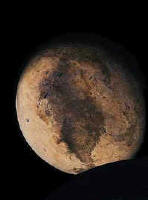 Much "kerfaffle" has been in the works this past few weeks, as Men With Large Degrees and Brains debate the classification of the tiny little planet, Pluto. Of course, Pluto is not longer a planet, and thus I will begin referring to it as Dwarf Planet - a new category of planets.
Much "kerfaffle" has been in the works this past few weeks, as Men With Large Degrees and Brains debate the classification of the tiny little planet, Pluto. Of course, Pluto is not longer a planet, and thus I will begin referring to it as Dwarf Planet - a new category of planets.
Dwarf planet? Pluto? Shouldn't we rename it Doc, Sleepy or Bashful??
I think a great amount of confusion regarding this reclassification (how rude of those Men With Large Degrees and Brains!) is due to a lack of understanding (among Those With Large and Small Brains But No Astrophysics Degrees) of what makes a plant an actual planet. It all comes down to a series of mathematical formulas (of course, doesn't it always) dealing with Kepler's Law.
Johannes Kepler first presented his theories to his mentor (Tycho Brahe) in the early 1600's. They soon became recognized as Kepler's Three Laws: 
1. The path of the planets about the sun are elliptical in shape, with the center of the sun being located at one focus (The Law of Ellipses).
2. An imaginary line drawn from the center of the sun to the center of the planet will sweep out equal areas in equal intervals of time (The Law of Equal Areas).
3. The ration of the squares of the periods of any two planets is equal to the ratio of the cubes of their average distances from the sun (The Law of Harmonies).
Pluto, you are in direct violation of the law! Cease your orbit and submit yourself to Men With Large Degrees and Brains for reclassification!
How the hell does Pluto break the Law? Pluto, an ornery little gal, has a large eccentricity when compared to the other eight planets of our solar system. She doesn't want to play nice, bulks at convention, and is content to dance to her own tune.
Eccentricity? What's that? Remember the Law of Ellipses? Let's look at that one (with a little help from The Physics Classroom. "Kepler's first law - sometimes referred to as the law of ellipses - explains that planets are orbiting the sun in a path described as an ellipse. An ellipse can easily be constructed using a pencil, two tacks, a string, a sheet of paper and a piece of cardboard. Tack the sheet of paper to the cardboard using the two tacks. Then tie the string into a loop and wrap the loop around the two tacks. Take your pencil and pull the string until the pencil and two tacks make a triangle. Then begin to trace out a path with the pencil, keeping the string wrapped tightly around the tacks. The resulting shape will be an ellipse. An ellipse is a special curve in which the sum of the distances from every point on the curve to two other points is a constant. The two other points (represented here by the tack locations) are known as the foci of the ellipse. The closer together which these points are, the more closely that the ellipse resembles the shape of a circle. In fact, a circle is the special case of an ellipse in which the two foci are at the same location. Kepler's first law is rather simple - all planets orbit the sun in a path which resembles an ellipse, with the sun being located at one of the foci of that ellipse." Eccentricity and Pluto: All the other planets follow the same dull routine. Pluto, as I mentioned, dances to its own drum. Pluto has a very eccentric orbit - meaning that its distance from the sun varies a lot during its orbit around the Sun. Sometimes it is even closer to the Sun than the planet Neptune. Pluto also breaks the rules in other ways. It rotates around its axis in the opposite direction from most other planets. Its orbit is tilted from the plane of the ecliptic, and this angle, its orbital inclination, is 17.15 degrees - the largest inclination of any of the planets. To put that into terms we can understand, look at the top of your table or deck with your monitor being the Sun. All the planets slide along the surface of the desk in a circle, going 'round your monitor smoothly. (Before I get bombarded via email by Men With Large Degrees and Brains - yes, I am aware that this isn't a scientifically accurate representation, but honestly, you do need to get your noses out of the books and learn to interact with people!) Back to the example - if you look, you will see eight little planets circling around your monitor, content to slide over the surface of your desk in cosmic harmony. Suddenly, a little marble pops up from the surface near the left-hand bottom corner of the monitor, leaps over the right hand corner of your monitor, glides around to the back, only to disappear behind the left-hand rear corner. If you watched it long enough, you'd notice that sometimes the marble would pop through the desk much closer than Neptune, and stay in that closer orbit for a while before finding its way back to the outskirts of the orbits.
Eccentricity and Pluto: All the other planets follow the same dull routine. Pluto, as I mentioned, dances to its own drum. Pluto has a very eccentric orbit - meaning that its distance from the sun varies a lot during its orbit around the Sun. Sometimes it is even closer to the Sun than the planet Neptune. Pluto also breaks the rules in other ways. It rotates around its axis in the opposite direction from most other planets. Its orbit is tilted from the plane of the ecliptic, and this angle, its orbital inclination, is 17.15 degrees - the largest inclination of any of the planets. To put that into terms we can understand, look at the top of your table or deck with your monitor being the Sun. All the planets slide along the surface of the desk in a circle, going 'round your monitor smoothly. (Before I get bombarded via email by Men With Large Degrees and Brains - yes, I am aware that this isn't a scientifically accurate representation, but honestly, you do need to get your noses out of the books and learn to interact with people!) Back to the example - if you look, you will see eight little planets circling around your monitor, content to slide over the surface of your desk in cosmic harmony. Suddenly, a little marble pops up from the surface near the left-hand bottom corner of the monitor, leaps over the right hand corner of your monitor, glides around to the back, only to disappear behind the left-hand rear corner. If you watched it long enough, you'd notice that sometimes the marble would pop through the desk much closer than Neptune, and stay in that closer orbit for a while before finding its way back to the outskirts of the orbits.
For decades, the debate over Pluto's plant status has been a hot one. It remained a planet until August 24, 2006 - because it does not want to fit into Kepler's Law. Does this downgrade her as far as interest goes? Not at all, for Pluto is still a beautiful object to view. This classification, by the way, does not stop with Pluto; we have discovered other solar systems, and the planets all follow Kepler's Laws. The discovery of anarchist "Pluto's" in other solar systems would be amazing, but it is nice to think that our own solar system can be picked out among the heavens simply because we do have a designator such as Pluto dancing around. We are no longer "That Solar System with Nine Planets and A Lot of Noise." Rather, we are now a solar system containing eight plants and several dwarf planets.
Some other fascinating facts about this little dwarf:
Pluto's name: It was once called Plant X, and does have its own moons. Percival Lowell calculated the rough location of Planet "X's" orbit, but died in 1916 before it was found. American astronomer Clyde W. Tombaugh found the planet in 1930, and named it Pluto. The name itself is after the Roman God of the underworld,  Pluto. (One of Pluto's moons, Charon (discovered in 1978), is named after the mythological demon who ferried people across the mythological river Styx into Hades.) The Dwarf Planet's symbol the combined letters "P" and "L", either for Pervical Lowell or for Pluto. The name, by the way, was suggested by Venetia Burney of England, who was eleven years old at the time. She suggested the name to her grandfather, who was Librarian at Oxford. He passed her idea to the astronomers who were trying to name the newly-discovered planet (ahem, Dwarf Planet).
Pluto. (One of Pluto's moons, Charon (discovered in 1978), is named after the mythological demon who ferried people across the mythological river Styx into Hades.) The Dwarf Planet's symbol the combined letters "P" and "L", either for Pervical Lowell or for Pluto. The name, by the way, was suggested by Venetia Burney of England, who was eleven years old at the time. She suggested the name to her grandfather, who was Librarian at Oxford. He passed her idea to the astronomers who were trying to name the newly-discovered planet (ahem, Dwarf Planet).
The Headline News Story from AP can be seen at Astronomers Give Pluto the Boot as Planet.
Pluto: the cold, icy... thing?
Tags:
Nature,
Science and More,
Writing
Subscribe to:
Post Comments (Atom)

7 responded with...:
Now THAT was a fun science lesson. And I love the word, kerfaffle.
Kepler's laws apply to all bodies in orbit. Earth's moon, Mars' moons,
and Jupiter's et cetera.
Saturn's rings follow Kepler's laws,
and comets as well,
with their very
eccentric orbits.
Binary, trinary and quadranary stars also follow Kepler's laws.
I believe Kepler phased his laws
refering to planets, because
Brahe's observations were of
planets.
Still, I believe I prefer Pluto
as a planet, even a minor one.
N'tran
TY for the good input, N'tran! I believe the same, when it comes to Brahe, and Kepler's approach to it.
I'm not really certain why Pluto got the boot. Perhaps it is because we can point to other heavenly objects, such as comets, and define them as "comets", while Pluto is doomed to a downsized fate of DP. I do applaud the decision to not classify moons as planets, however.
Damn this Twenty-First Century technology!
Thanks, Annie, for this link!
http://www.blogger.com/comment.g?blogID=14191109&postID=115654380342798242 for all those school teachers out there.
i never imagined this in my lifetime.
Copied from the AP story:
Pluto, a planet since 1930, got the boot because it didn't meet the new rules, which say a planet not only must orbit the sun and be large enough to assume a nearly round shape,
but must
"clear the neighborhood around its orbit."
That disqualifies Pluto, whose oblong orbit overlaps Neptune's,..
Astronomers have labored without a universal definition of a planet since well before the time of Copernicus.
End Snip
Now in 2006, astromnomers,
[Men with Large Degrees and Brains]
are trying to define a planet.
1]Spherical, or nearly so...
2]In orbit around the sun
so far so good
3]Clear the neighborhood near it's orbit.
Oops.
I don't believe there is
a defintion for asteroid
or comet either.
N'tran
N'tran, your clarification rocks (no pun intended!)
Thanks!
Post a Comment